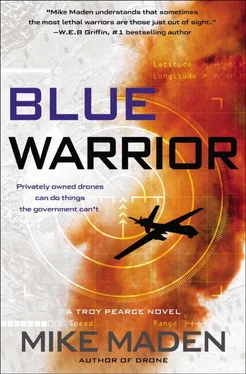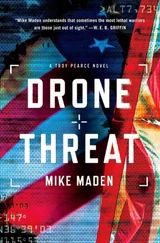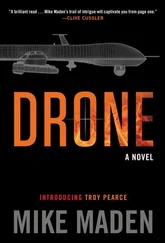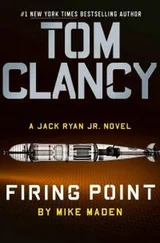Myers gave a brief explanation of her visit to Justice Tanner and his subsequent suicide, along with the strong suspicion that she was being watched by whoever had blackmailed him.
“What evidence do you have of blackmail?”
“I knew the man for twenty years. His suicide was both an apology and, I think, a clue.”
“Clue?”
“He was very nervous and hostile when I met with him. I’ve never known him to be either. Whoever had the power to blackmail him probably had the ability to keep him under surveillance. I think that’s why he was nervous and hostile. Probably trying to protect me, though I didn’t see it at the time. If he had been blackmailed he couldn’t say anything to me if he was under surveillance, so I believe he might have killed himself in order to invite an investigation.”
“If you don’t mind my saying, that’s a bit of a stretch.”
“Maybe. But he seemed to bear the weight of an enormous amount of guilt for violating his own principles. The weight of history, too. His controversial opinion will be read and criticized for as long as there are law books.”
“So his death could be the result of guilt, but the basis of a clue. That makes sense, though it would hardly stand up in a court of law.”
“I initiated a few search queries two days ago. My own security measures indicated that I was being monitored. Without question, I know I’m on the right path. I’m determined to find out who is behind his death.”
“Do you have a course of action in mind?”
“Yes, and I’m going to need your help. We need to start digging, but we need to do it in a very secure way; otherwise, I’m afraid we’ll both be targeted by the same people who came after Vin. I’m willing to take the risk, but I won’t put you or Pearce Systems in jeopardy.”
“No worries there. This is what we do. Where do we start?”
“I always start with a simple question. Who benefits?” Myers knew the K Street game well enough to know that changes in legislation and regulation could be even more profitable than just simple cash transfers. Politicians and lobbyists—many of whom were former politicians—were obvious candidates.
Wall Street banksters and hedge fund managers would have also benefitted from the ruling, and that would be another place to start. But something told Myers that was too obvious. The sophistication of the malware that tried to infect her motherboard’s BIOS suggested more advanced software abilities than the average stockbroker usually possessed.
On the other hand, a few Wall Street firms hired the best mathematicians and software engineers to create and execute blindingly fast investing algorithms—“robo-traders” or “algos”—that made faster, better, and emotionless computer-generated trades in milliseconds throughout global markets. Often utilizing high-speed data (HSD) sold to them by the exchanges themselves, institutional investors made billions in high-frequency trading. HFT was responsible for at least half if not more of all Wall Street transactions these days, turning massive profits on fractional stock movements, or legally “front-running” trades made by slower investors. Profits, like war, depended on beating opponents to the punch. Speed was everything, and no human trader could ever hope to keep up with the automated systems. The same would be true in war, Myers feared. Automated generals and admirals could eliminate future conflicts by displaying their drone squadrons and rebotic fleets more swiftly and decisively than their human counterparts.
Of course, all of that data harvesting and processing relied heavily on hardware and software systems. When the algorithms failed, “flash crashes” and other high-speed-data train wrecks occurred. But billions of dollars in profits were being harvested by these “drone” trading systems. They also had to be protected by sophisticated hardware and software security systems in order to safely conduct billions of financial transactions every day, accurately and securely. So, yes, there were Wall Street suspects, too, along with the politicians and lobbyists. Come to think of it, a number of Wall Street figures were also former politicians and lobbyists. In fact, they were all interchangeable parts of the same vast machine. This would be a difficult knot to try to untangle.
“Let’s talk about this for a moment,” Myers said. She drummed her fingers on the desktop. “Tanner made an outrageous legal decision. Thousands, if not millions, of people stand to profit in some way from it—some more than others. A few of those would have benefitted the most, so they would have had the most to gain. But the outrageousness of the decision tells me that the leverage they had over him must have been unbelievable. Big decision, big threat, big payoff. Make sense?”
“Impeccable logic.”
“But what could the deep, dark secret have been? Tanner would have been vetted for every significant position he ever held, including the Colorado Supreme Court, but even before he was formally nominated to the United States Supreme Court, we had the FBI conduct a standard background check. So either Tanner did something terribly wrong after he was confirmed to his appointment, or something he had done was very ancient and very well hidden. The first scenario speaks to ongoing surveillance, and the latter to extreme research capabilities, don’t you agree?”
“Agreed. In either scenario, government resources most likely would be needed.”
“Or a government contractor.”
“Or it could have been a stroke of bad luck that someone happened to stumble across something.”
“That’s like saying someone stumbled across buried treasure. No, you have to dig for buried treasure, and the bigger the treasure, the deeper you hide it. Besides, I don’t know how to write an algorithm for luck. If I did, I’d use it to play Powerball, wouldn’t you?”
“Another possibility would be faked evidence of some sort.”
“You didn’t know Vin Tanner,” Myers said. “If someone had ginned up fake evidence, he’d fight tooth and nail against it.”
“Unless the false evidence was so well documented that he knew he couldn’t fight against it, or worse, maybe he even believed it.”
“I’m not following you.”
“You know, something like ‘Here is a picture of you with this person when you were drunk. You just don’t remember doing this terrible thing with them because you were so drunk.’ Most people believe visual evidence, even if it contradicts their beliefs. It’s so easy to fake photographs these days. It’s very difficult to trust anything digital.”
“I agree. Faked evidence is a possibility. But I still believe we’re talking about a government agency or government contractor. But you know government people. They all talk. So if the word never got out about this, then it must have been a very small operation.”
“Rogue perhaps?”
“Not authorized, for sure. At least, not legally.”
“Where does that leave us?” Ian asked.
“A few people who stood to most benefit from a single, outrageous decision utilized one or a few highly capable research and/or surveillance people to find or create blackmail data on Justice Tanner. So at least the numbers of actual participants seems to be shrinking. But the number of candidates is still huge, counting just high-ranking politicians and Wall Street CEOs. Let’s try two tacks. First, can you put together some sort of search query about outrageous decisions?”
“That’s a rather indefinable and unquantifiable search parameter, don’t you think?”
“We can attack it in two ways. First, we can tackle this from a political angle. We can look at all committee and subcommittee hearings, selecting out those focused on big-budget items like defense or regulations that affect big financial institutions.”
Читать дальше












